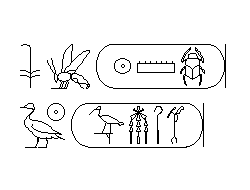
The son of Tuthmosis II and a minor wife. After the early death of his father, he succeeded to the throne as a child, his rule being confirmed by an oracle of Amun. His stepmother, Hatshepsut, originally acted as regent, but quickly assumed the titulary of a (male) pharaoh herself. For many years Tuthmosis III remained in the background, and only after her death was he able to rule alone. On many of her monuments after her death, but very late in his reign, he replaced Hatshepsut's name with his own, or with those of Tuthmosis I or Tuthmosis II, for example in the temple of Deir el-Bahari. Tuthmosis III undertook several military campaigns in Asia, where he conquered vast areas. Everywhere he went he left Egyptian garrisons behind. The king even penetrated as far as the river Euphrates. The result of this campaign was that the rulers of the city states of Palestine and Syria became vassals of Egypt. Tuthmosis III caused the successful results of his campaigns to be recorded in the temple of Karnak. The tomb of Tuthmosis III in the Valley of the Kings contains one of the earliest representations of the Amduat. The king's mummy was reburied in the 21st Dynasty by order of the High Priest Pinedjem II in a hidden rock tomb near Deir el-Bahari, to protect it against further robberies. The tomb, which also contained the remains of several other kings, was only rediscovered at the end of the nineteenth century.